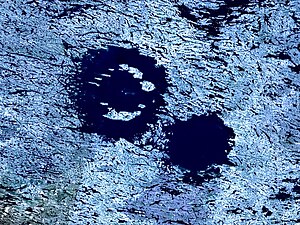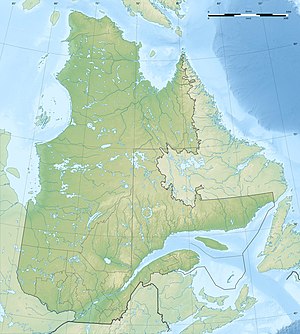Lac à l'Eau Claire
| Lac à l'Eau Claire | ||
|---|---|---|

|
||
| Images from NASA World Wind | ||
| Geographical location | Nunavik region in North du Québec , Québec (Canada) | |
| Drain | Rivière à l'Eau Claire | |
| Islands | Île Atkinson | |
| Data | ||
| Coordinates | 56 ° 8 ′ N , 74 ° 18 ′ W | |
|
|
||
| Altitude above sea level | 241 m | |
| surface | 1 383 km² | |
| length | 71 km | |
| width | 33 km | |
| Maximum depth | 178 m | |
| Catchment area | 3830 km² | |
|
particularities |
||
The Lac à l'Eau Claire ( English Clearwater Lakes , Cree language: Wiyasakami , Innu language: Allait Qasigialingat ) is formed from two interconnected circular partial lakes in the Canadian Shield in the Canadian province of Quebec near Hudson Bay .
The two partial lakes are separated by a series of islands - similar to a dotted line. Thus the Lac à l'Eau Claire consists of an east and a west part.
The area is 1383 km², the net water area 1253 km², the water surface is 241 m, the maximum water depth is 178 m.
The coordinates of the two partial lakes are:
Eastern partial lake: ( 56 ° 3 ′ 44 ″ N , 74 ° 6 ′ 50 ″ W )
Western partial lake: ( 56 ° 13 ′ 50 ″ N , 74 ° 29 ′ 13 ″ W )
The name of the lake is derived from its clear water. In fact, there are 25 lakes with the same name in Québec alone. Lac à l'Eau Claire is the second largest natural lake in Québec after Lac Mistassini .
The explorer and geologist Albert Peter Low described the exceptionally clear water of the lake in 1896.
Impact crater
The two partial lakes fill circular depressions, both of which have been verified as impact craters . The eastern crater is 26 km in diameter, the western crater at least 36 km. Until recently, both craters were believed to be the same age, 290 ± 20 million years ( Permian ), and it has been widely believed since 1965 that they formed simultaneously when a double asteroid impacted. More recent age dating of impactites of both craters by means of argon-argon dating , however, revealed significantly different geological ages. The western crater is 286.2 ± 2.6 million years old (early Permian), the eastern crater, however, is 460-470 million years old ( Ordovician ). In addition, the composition of the respective impact rocks, their geophysical properties (natural remanence ) and the geochemical fingerprint of the respective meteorites are different for both impact craters. The Clearwater craters, like the two smaller Suvasvesi craters in Finland, only appear to be a pair of impact craters.
Microclimate
Because of its size, the lake has an impact on the regional microclimate , as evidenced by the occurrence of certain plant species. Although the lakeshore is mainly populated by boreal plant species, the centrally located islands in the western part of the lake are characterized by arctic species, which makes them an arctic enclave .
Planned provincial park
A large area around the lake, including Lac Guillaume-Delisle , Lacs des Loups Marins , Petit Lac des Loups Marins and Lac D'Iberville , is under investigation in preparation for a new provincial park . The planned park would be the largest park in Québec with 15,549 km² (excluding wilderness reserves).
Individual evidence
- ↑ a b The Atlas of Canada - Lakes ( Memento from January 14, 2013 in the Internet Archive ) (English)
- ↑ a b c d Lac à l'Eau Claire, Commission de Toponymie Québec
- ↑ a b c d e Ministère du Développement durable, de l'Environnement et des Parcs, Provisional Master Plan Parc national des Lacs-Guillaume-Delisle-et-à-l'Eau-Claire , Quebec, 2008, ISBN 978-2- 550-52710-7 ( online version ; PDF; 6.4 MB)
- ↑ R-ArcticNet - EAU CLAIRE (RIVIERE AL) A LA SORTIE DU LAC L'EAU CLAIRE
- ↑ a b Statistics Canada> summary tables> Principal lakes, elevation and area, by provinces and territories ( Memento of the original of July 6, 2011 in the Internet Archive ) Info: The archive link was automatically inserted and not yet checked. Please check the original and archive link according to the instructions and then remove this notice.
- ^ Robertson, PB & Grieve, RAF 1975 Impact structures in Canada: Their recognition and characteristics. Journal of the Royal Astronomical Society of Canada , v. 69, pp. 1-21.
- ^ Earth Impact Database
- ^ Schmieder, M., Schwarz, WH, Trieloff, M., Tohver, E., Buchner, E., Hopp, J. & Osinski, GR 2014. New 40 Ar / 39 Ar dating of the Clearwater Lake impact structures (Québec , Canada) - Not the binary asteroid impact it seems? Geochim. Cosmochim. Acta (in press).
